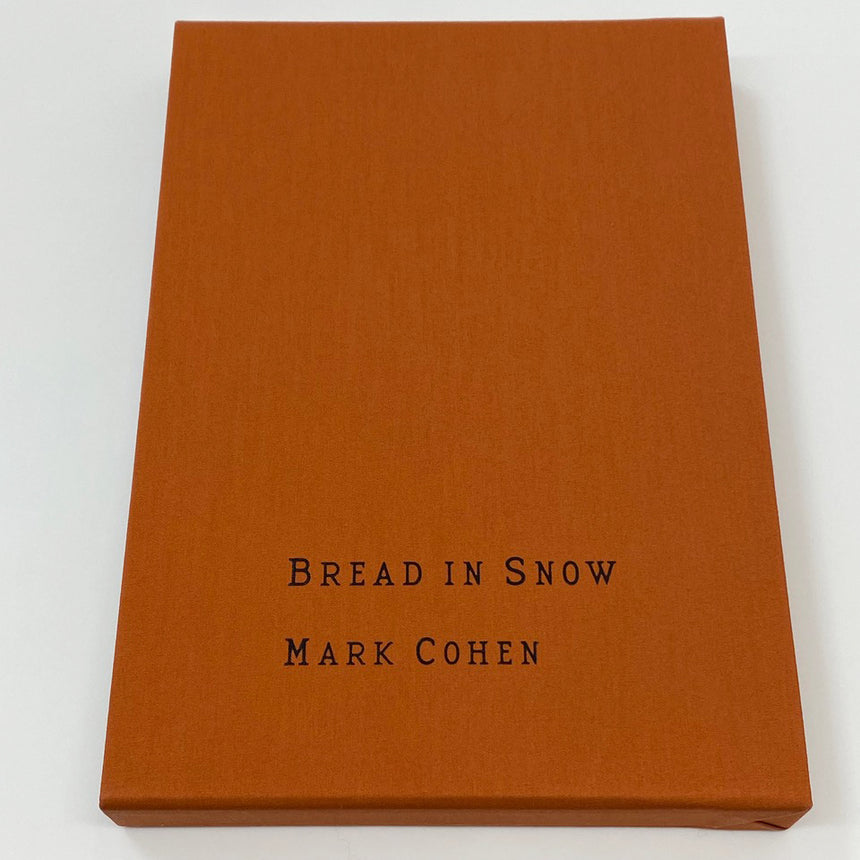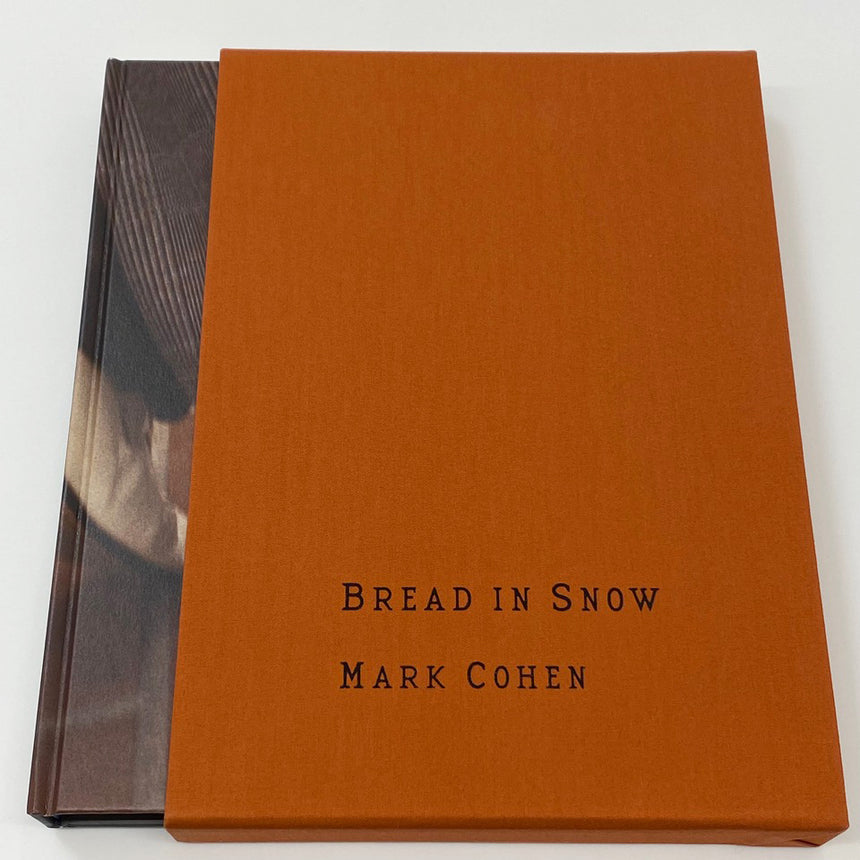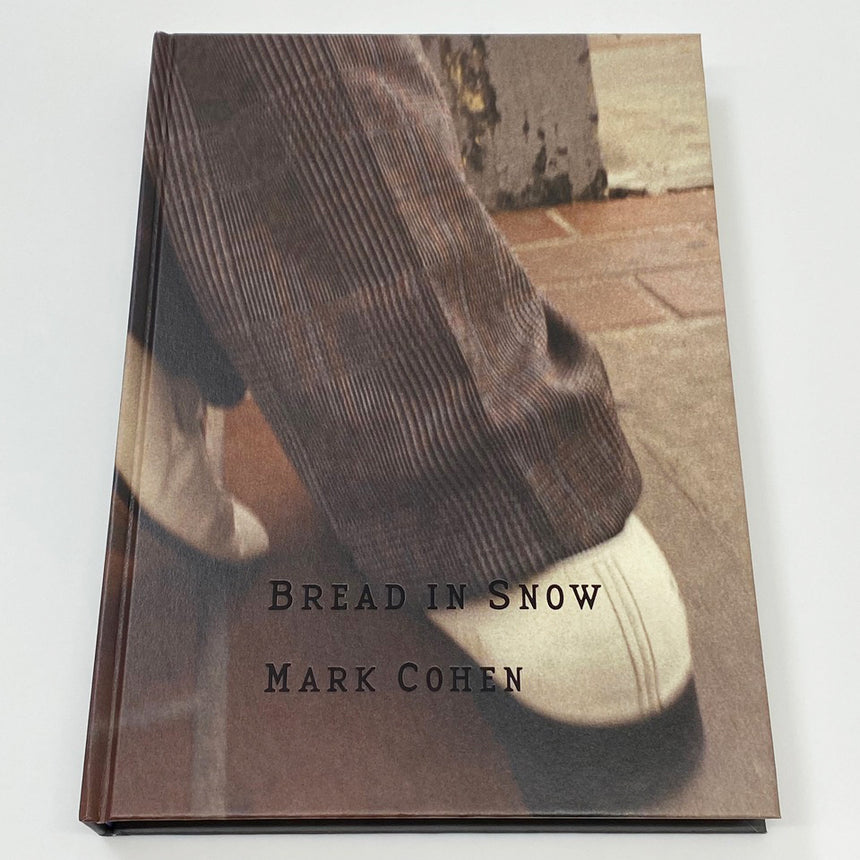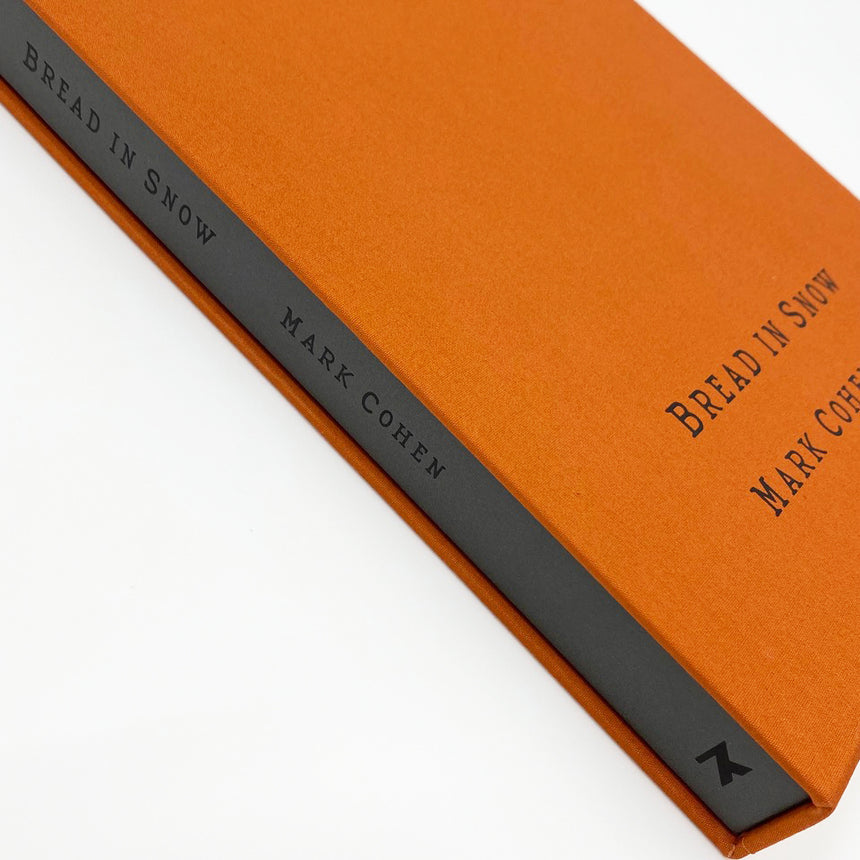Bread in Snow
Slipcase edition
Mark Cohen
¥8,500 JPY
Limited edition of 200
The gray cover book is housed in a slipcase.
Published in 2019
ISBN 978-4-908512-78-0
The gray cover book is housed in a slipcase.
Published in 2019
ISBN 978-4-908512-78-0
This book shows a rangeof color images at the edges of a whole work.
Pictures that emerge from the basic half unconscious framing learned on the street.
In the case of the picture of the woman’s clasped hands- it was this fragment -suddenly in the frame- at the bus stop, not composed, but quickly centered, that was the start of the picture. One hand is bare and one is gloved and the fact of the color film in the camera is almost incidental. After developing the film the glove she is wearing is distinctly red-but at the time of the exposure-putting the camera lens so close to the clasped hands - was a much more intense experience-then the trespass into her personal space.
Color added additional voice to pictures.I felt they gained energy, and accidental social, meaning as I walked through the city attracted by almost anything. Any eye contact was a factor. A wire, or a step. There is still no plan or theory about this work. It just developed and expanded for fifty years.Pictures were made into prints, all 11X14 or 16X20 inches, then into boxes after a long series of exhibits.I started to make pictures commercially in high school. Most of the these pictures were portraits of children printed as 16X20 inch black and white pictures ,dry mounted ,that I took in the backyards of these kid’s homes and then made contact sheets for proofs to show their parents.This was in 1960.
It was always a completely separate operation. I knew about Kodachrome and Ektachrome, and Kodacolor, but all these color techniques were far too expensive to print.
My own work was black and white and printed in my darkroom.Some of the first ,real, color pictures I made,in heated trays of chemicals, were when Vericolor II film was introduced by Kodak in the early 1970’s.It was the same ‘speed’ as Tri-x and so could be used with the same camera settings as the b/w film. At first I thought I would try to forget which film I had in the camera since the power of the pictures was not driven by the film in the camera. It was stimulated by a psychological interaction between meand what I saw as I walked along in the streets and alleys of Wilkes-Barre.The earliest pictures in this book are from those negatives.Then in 1977 I used a whole year making color pictures and this film was developed and proofed by Kodak as part of a project with the George Eastman House.
The last set of images is from 1987. In that year I used only Fuji 1600 color negative film.
It is a very fast film so perfect for the fast.close, street photography I was doing.
Pictures that emerge from the basic half unconscious framing learned on the street.
In the case of the picture of the woman’s clasped hands- it was this fragment -suddenly in the frame- at the bus stop, not composed, but quickly centered, that was the start of the picture. One hand is bare and one is gloved and the fact of the color film in the camera is almost incidental. After developing the film the glove she is wearing is distinctly red-but at the time of the exposure-putting the camera lens so close to the clasped hands - was a much more intense experience-then the trespass into her personal space.
Color added additional voice to pictures.I felt they gained energy, and accidental social, meaning as I walked through the city attracted by almost anything. Any eye contact was a factor. A wire, or a step. There is still no plan or theory about this work. It just developed and expanded for fifty years.Pictures were made into prints, all 11X14 or 16X20 inches, then into boxes after a long series of exhibits.I started to make pictures commercially in high school. Most of the these pictures were portraits of children printed as 16X20 inch black and white pictures ,dry mounted ,that I took in the backyards of these kid’s homes and then made contact sheets for proofs to show their parents.This was in 1960.
It was always a completely separate operation. I knew about Kodachrome and Ektachrome, and Kodacolor, but all these color techniques were far too expensive to print.
My own work was black and white and printed in my darkroom.Some of the first ,real, color pictures I made,in heated trays of chemicals, were when Vericolor II film was introduced by Kodak in the early 1970’s.It was the same ‘speed’ as Tri-x and so could be used with the same camera settings as the b/w film. At first I thought I would try to forget which film I had in the camera since the power of the pictures was not driven by the film in the camera. It was stimulated by a psychological interaction between meand what I saw as I walked along in the streets and alleys of Wilkes-Barre.The earliest pictures in this book are from those negatives.Then in 1977 I used a whole year making color pictures and this film was developed and proofed by Kodak as part of a project with the George Eastman House.
The last set of images is from 1987. In that year I used only Fuji 1600 color negative film.
It is a very fast film so perfect for the fast.close, street photography I was doing.
スケップケース入り写真集
限定50部 + 10APs
写真集(グレーの表紙)は特製のスリップケースに収められています。
Published in 2019
ISBN 978-4-908512-78-0
ISBN 978-4-908512-78-0
本書には、画面の縁ぎりぎりにイメージが収まったカラー写真が並んでいる。ストリートで学んだ基本である半ば無意識のフレーミングから生まれた写真群である。女性のしっかり組んだ手の写真の場合、わざとこの構図にしたわけではなく、バス停で突然この断片がフレームに入ってきて、素早くそれを中心に据えた。この写真はこうして生まれた。片方が素手でもう片方に手袋をはめていること、カメラにカラーフィルムが入っていたことは、ほとんど偶然だ。現像してから手袋が赤だったことを認識したくらいで、撮影したときは、組んだ手にレンズを近づけ、彼女の私的空間に侵入していくことの方がはるかに緊迫する体験だった。色彩は写真にさらなる声を与えた。写真はエネルギーを得たし、偶発的な社会的意味をもったと感じた。私はありとあらゆるものに惹きつけられつつ、街を歩き回った。視線が合えば、そのすべてが要素になった。鉄線、あるいは踏み台。今でもこの仕事に計画や理論はない。50年の間にただ発生して成長していった。本書の写真は11×14インチ、あるいは16×20インチのプリントにして、長期間続いた展覧会を経て、箱に収められていた。
私は高校生のとき、仕事として写真を撮り始めた。ほとんどは子どものポートレートで、彼らの自宅の裏庭で撮ったものだった。16×20インチのモノクロプリントをドライマウントしていた。彼らの保護者に見せるため、コンタクトシートも作成した。1960年代のことだ。これらはいつも単発の仕事だった。コダクロームもエクタクロームも知ってはいたが、それらのフィルムをプリントするのは極めて高価だった。私はもっぱらモノクロで、自分の暗室で現像していた。薬剤のトレイを温めたりしてカラー写真に取り組むようになったのは、べリカラーIIがコダックから発売された1970年代の初めだった。これはトライ–Xと同じスピードで、モノクロ写真と同じカメラ設備で撮影することができた。最初は、どちらのフィルムがカメラに入っているかを忘れるようにしていた。というのは、写真の力はフィルムによって左右されるわけではなかったからだ。これらの写真は、ウィルクスバリ(ペンシルヴェニア州の都市)の大通りや路地を歩いているとき、自分が見たものと自分との心理的な相互作用から刺激されたものだった。本書で最も早い時期の写真群は、これらのネガから焼いたものだ。1977年には、1年を通じてカラー写真に取り組んだ。このフィルムはジョージ・イーストマン・ハウスの事業の一環として、コダックが現像し、プルーフをプリントした。最後のイメージ群は、1987年に撮影したものだ。この年、私はフジ1600のカラーネガフィルムだけを使用していた。これは高速で撮れるから、素早く接近する私のストリート写真には最適だった。
私は高校生のとき、仕事として写真を撮り始めた。ほとんどは子どものポートレートで、彼らの自宅の裏庭で撮ったものだった。16×20インチのモノクロプリントをドライマウントしていた。彼らの保護者に見せるため、コンタクトシートも作成した。1960年代のことだ。これらはいつも単発の仕事だった。コダクロームもエクタクロームも知ってはいたが、それらのフィルムをプリントするのは極めて高価だった。私はもっぱらモノクロで、自分の暗室で現像していた。薬剤のトレイを温めたりしてカラー写真に取り組むようになったのは、べリカラーIIがコダックから発売された1970年代の初めだった。これはトライ–Xと同じスピードで、モノクロ写真と同じカメラ設備で撮影することができた。最初は、どちらのフィルムがカメラに入っているかを忘れるようにしていた。というのは、写真の力はフィルムによって左右されるわけではなかったからだ。これらの写真は、ウィルクスバリ(ペンシルヴェニア州の都市)の大通りや路地を歩いているとき、自分が見たものと自分との心理的な相互作用から刺激されたものだった。本書で最も早い時期の写真群は、これらのネガから焼いたものだ。1977年には、1年を通じてカラー写真に取り組んだ。このフィルムはジョージ・イーストマン・ハウスの事業の一環として、コダックが現像し、プルーフをプリントした。最後のイメージ群は、1987年に撮影したものだ。この年、私はフジ1600のカラーネガフィルムだけを使用していた。これは高速で撮れるから、素早く接近する私のストリート写真には最適だった。









